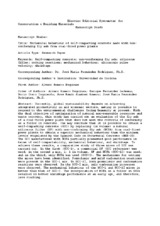Mechanical behaviour of self-compacting concrete made with non-conforming fly ash from coal-fired power plants
Autor
Romero Esquinas, Álvaro
Fernández Ledesma, Enrique
Otero, R.
Jiménez, José Ramón
Fernández, José María
Editor
ElsevierFecha
2018Materia
Self-compacting concreteNon-conforming fly ash
Siliceous filler
Setting reactions
Mechanical behaviour
Ultrasonic pulse velocity
Shrinkage
METS:
Mostrar el registro METSPREMIS:
Mostrar el registro PREMISMetadatos
Mostrar el registro completo del ítemResumen
Currently, global sustainability depends on achieving integrated productivity in all economic sectors, making it possible to respond to the environmental challenges facing humanity at present. With the dual objective of optimization of natural non-renewable resources and waste recovery, this study has carried out an evaluation of the fly ash of a coal-fired power plant that does not meet the criteria of conformity as a filler in concrete. One may conclude that it is possible to obtain a self-compacting concrete (SCC) by replacing (in volume) a natural siliceous filler (SF) with non-conforming fly ash (NCFA) from coal-fired power plants to obtain a superior mechanical behaviour than the minimum levels stipulated by the Spanish Code on Structural Concrete (EHE-08). The SCC manufactured with NCFA partially presented good performance in terms of self-compactability, mechanical behaviour, and shrinkage. To achieve these results, a comparative study of three mixes of SCC was carried out. In the first (SCC-1), a commercial SF (SCC reference) was used; in the second a mix, 1: 1 in volume, SF and NCFA (SCC-12) was used; and in the third, only NCFA was used (SCC-2). The mechanisms for setting the mixes have been identified. Pozzolanic and mild carbonation reactions were present in the SCC-1 mix. In SCC-12, both pozzolanic and carbonation reactions were observed. In the SCC-2 mix, only carbonation processes were observed. The mechanical behaviour of the SCC-1 and SCC-12 mixes is better than that of SCC-2. The incorporation of NCFA as a filler in SCCs resulted in better shrinkage performance at an early age, and therefore, less cracking.

